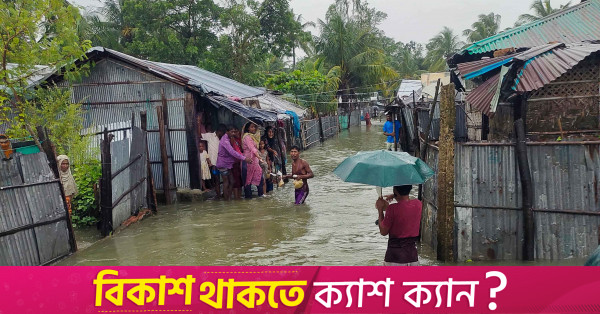What makes Cox’s Bazar waterlogging so severe? Locals blame two roads worth Tk586cr


Abul Qasem Sikder says he has never witnessed such severe waterlogging before. He blames it on the construction of the road, the four-lane link road from the Laboni intersection to the Kolatoli area, a key part of Cox’s Bazar’s tourism zone.
“Because of the road, waterlogging has become a regular occurrence during heavy rainfall,” Abul Qasem, president of the Cox’s Bazar Hotel-Motel Guest House Owners’ Association, told TBS yesterday.
“The four-lane road was built higher than the previous road and has narrower drains. Additionally, the drains were covered with slabs, obstructing the flow of water. The road’s design failed to provide a proper pathway for rainwater to drain into nearby rivers or the sea.
“Moreover, soil from nearby hills has filled up the drains, further exacerbating the problem. Several heavy rains last July also inundated the hotel-motel zone,” he said.
Previously unaffected by waterlogging, the Kolatoli area has been inundated four times in the past three months.
Most recently, three consecutive days of heavy rainfall, including Friday’s record-breaking rain, flooded most of the town and about 200 villages in the district, with water yet to recede from several areas.
Several areas, including Bazarghata, Borobazar, Anderson Road, Tekpara, Burmese Market, Buddhist Temple Road, and Goldighirpar, experienced severe waterlogging.
The flooding affected shops, offices, businesses, and submerged thousands of homes. Speaking to TBS, residents voiced their concerns over the worsening situation.
“The five-kilometre main road of Cox’s Bazar town is in the same condition as the link road,” said Ayazur Rahman, president of Cox’s Bazar Bachao Andolon and a senior lawyer.
“It took more than three years to repair this road, and it was elevated by nearly three feet, which left businesses and markets at a lower level. The drains associated with this road are clogged with garbage and debris, and the slabs covering them prevent cleaning.
The elevated road now obstructs the flow of water from the southern areas to the northern Bakkhali River, causing severe waterlogging during heavy rainfall and landslides.”
Cox’s Bazar Chamber of Commerce and Industry President Abu Morshed Chowdhury Khoka similarly blamed the road projects for the waterlogging in the town.
“The unplanned, unusually high, slab-covered road projects, worth about Tk6 crore, have now become the cause of suffering. These roads have blocked the drainage system, leading to recurrent waterlogging during rainfall,” he said.
Sifat, a businessman at Motel Labonee Market, reported that his establishment has been flooded four times in the last three months due to the blocked drains. “This suffering is the result of poorly planned development projects,” he said.
The four-lane 71-feet road from Laboni intersection to the Kolatoli area was constructed by Cox’s Bazar Roads and Highways Department. Work on this project began in November 2019. It was inaugurated in December 2022.
The project, valued at Tk288 crore, included a 10-foot central divider and six-foot drains on both sides. Of the allocated funds, Tk90 crore was paid as compensation for land acquisition, while the rest was used for road construction.
The other project, renovation of the town’s main road from Holiday Mor to Bazarghata via Larpara Bus Terminal, was implemented by the Cox’s Bazar Development Authority. The project, costing Tk298.14 crore, was initiated in July 2019 and was inaugurated in December 2022.
Ridwan Ali, coordinator of the Cox’s Bazar Nagorik Forum, noted that there were strong protests against making the main road abnormally high during its renovation, but they were ignored.
“The construction of the road with closed drains covered by slabs means it cannot be cleaned, leading to the current situation. The residents are now bearing the brunt of this negligence,” he said.
Meanwhile, the rainfall in Cox’s Bazar decreased slightly yesterday compared to Friday.
While water has receded from most waterlogged areas in the town, some 200 villages across six upazilas, including Sadar, remain inundated.
Assistant Meteorologist Abdul Hannan of the Cox’s Bazar weather office reported that 210 mm of rainfall was recorded in the 24 hours from noon Friday to noon Saturday.
The previous 24-hour period saw 501 mm of rainfall—the highest in Cox’s Bazar’s history, surpassing the 437 mm recorded in August 2015.
With the slight decrease in rainfall, the situation in the town has improved, and water has receded from roads, beach areas, and market zones in Kolatoli.
However, eight low-lying areas, including Samitypara, Kutubdiayapara, Fadnardeil, and Nuniyachara, are still submerged.




